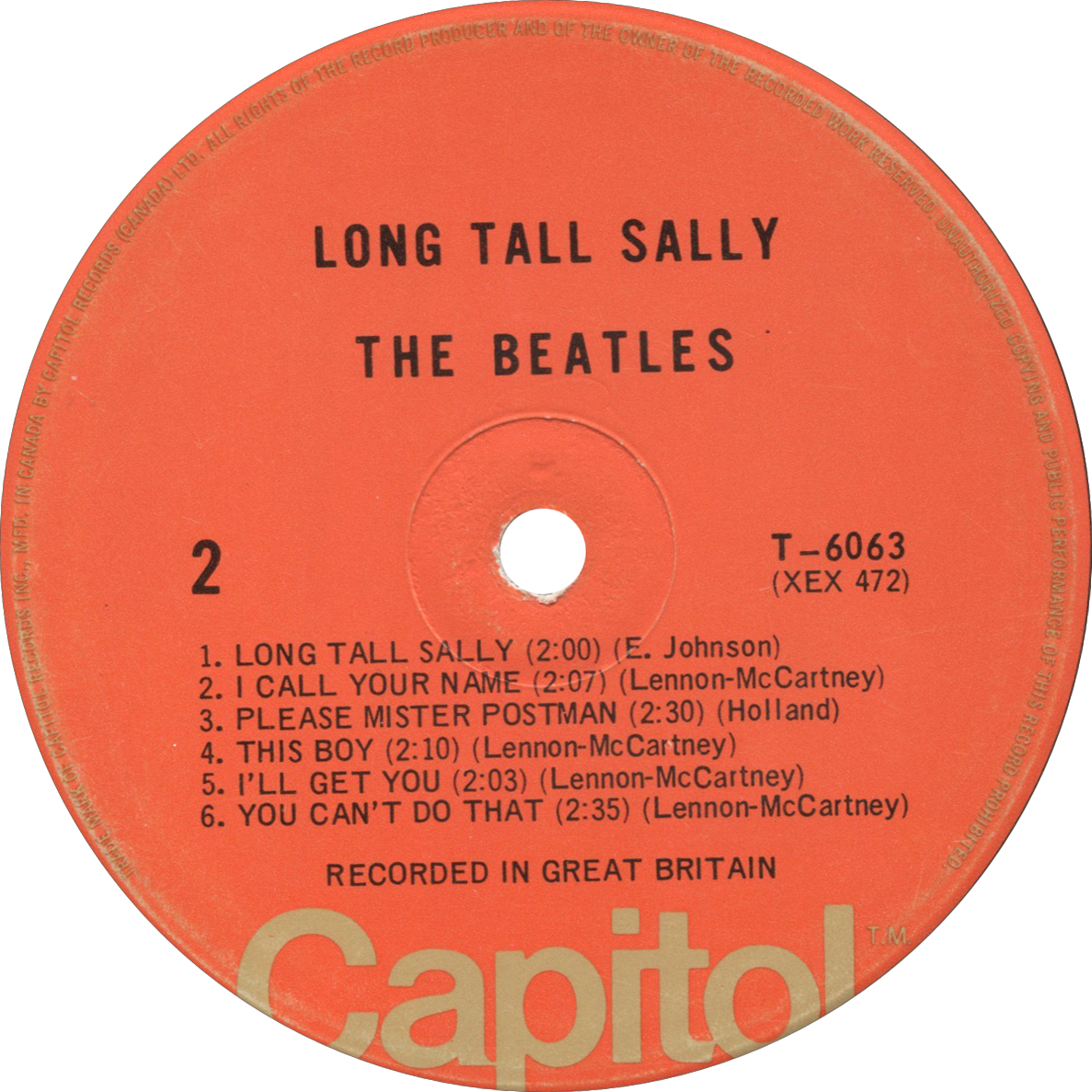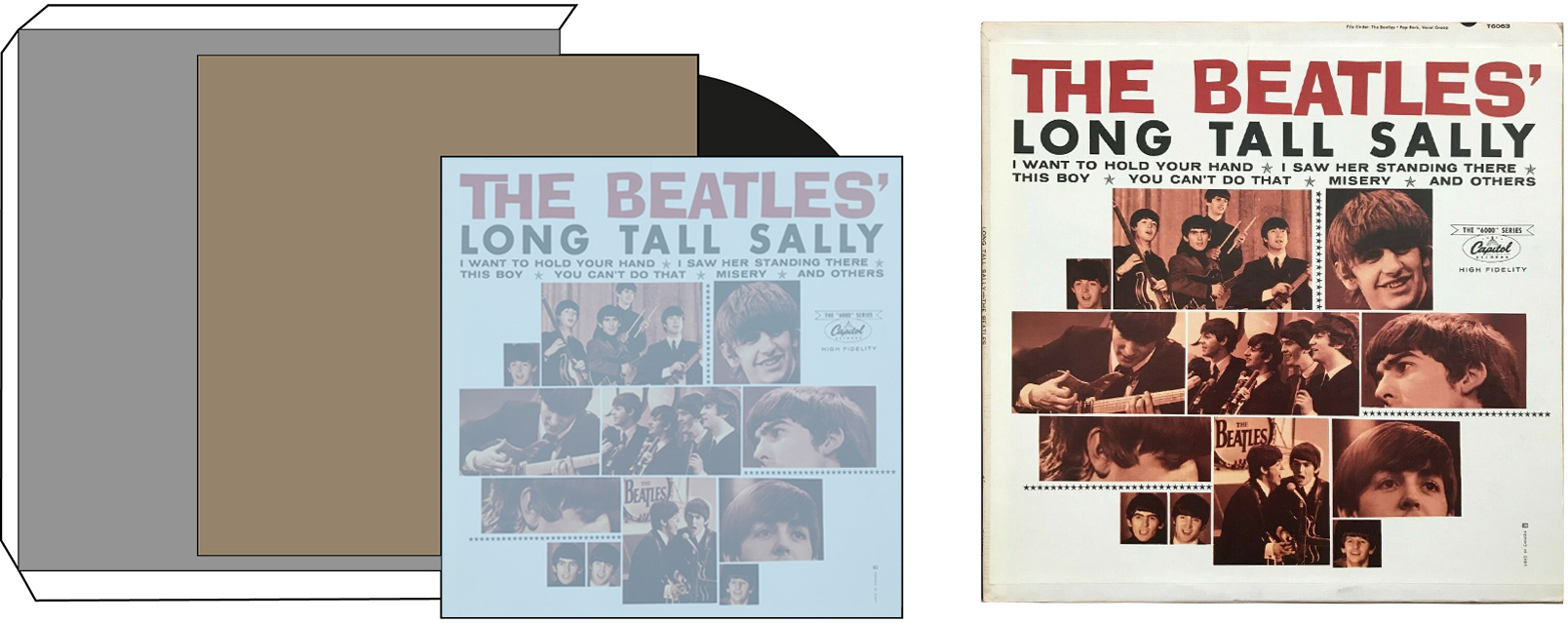← Long Tall Sally Variations List
Long Tall Sally
This album was a unique Canadian release
LP.6063.6.1 | Orange 1st generation
MG (Modern Graphics) Stereo Banner Cover
Variation LP.6063.6.1 was still released only in MONO, although it features a stereo banner cover. This pressing is recognized by its new orange label design with gold text, it features the new Dynaflex vinyl compound, but mostly, it is known for its Modern Graphics version of the mistake stereo banner cover.


Availability
This variation was available primarily in 1972 (for approximately a few months) before the stereo banner was trimmed off (see entry LP.6063.6.2).
General Information
Curiously, the mistake stereo arrow banner was carried onto this next pressing, to the new printer: Modern Graphics. This is the first pressing on the new orange label design.
Pressing Information
This pressing is more difficult to find today, and was soon replaced with the newer labels with black perimeter text in 1974. These first generation orange labels are the rarest of all three generations, as very few copies were pressed at the time (low demand).
Another curious fact about this pressing is that side 2 features a new lacquer that appears to have been cut by MCA (the o-o-o symbol in the runout). This seems unlikely that this is a Compo pressing, but it would seem that MCA prepared the new lacquer that was used at RCA for the Dynaflex pressing. This needs to be confirmed, but seems to be the most logical theory to date.
Side 1: XEX 455 471
side B: T-6063 - XEX - 472 o-o-o)

RCA's new Dynaflex technology
RCA's "Dynaflex" technology, introduced in the 1970s, was an innovative approach to manufacturing vinyl records. Dynaflex records were significantly thinner and more flexible than standard vinyl records of the time. RCA developed this technology in response to several issues with traditional records, including warping, breakage, and the cost of materials. Specifically:
Material and Thickness: Dynaflex records were made from a specially formulated vinyl that allowed them to be pressed thinner than conventional records. While standard vinyl records were around 120-150 grams, Dynaflex records typically weighed between 90-110 grams.
Flexibility: One of the most notable features of Dynaflex records was their flexibility. They could be bent and flexed without breaking, which made them more durable and less prone to warping.
Cost Efficiency: The thinner vinyl used in Dynaflex records reduced production costs. This was advantageous for RCA, allowing them to save on materials and shipping due to the reduced weight.
Sound Quality: While Dynaflex records were praised for their durability, there was some controversy regarding their sound quality. Audiophiles and critics often debated whether the thinner vinyl affected the audio fidelity. Some felt that Dynaflex records had less dynamic range and were more prone to surface noise.
The reception to Dynaflex was mixed. While some consumers appreciated the durability and lower cost, others preferred the traditional, heavier vinyl records for their perceived superior sound quality and tactile feel. Despite the mixed reviews, Dynaflex represented an interesting chapter in the history of vinyl record production, highlighting the industry's efforts to innovate and adapt to changing market conditions and technological advancements.
ALSO OF NOTE
The Dynaflex pressings with the smaller pressing ring were officially introduced in the Beatles catalogue around 1972-1973, but some earlier pressings with the traditional large RCA groove were found in the previous few years with a softer compound (e.g. Late rainbows, target labels and early orange label pressings). It is believed that RCA was experimenting with different vinyl compositions before officially introducing their new approach.
Cover
This pressing is also unique mostly because of its mistake STEREO Banner front slick printed this time by Modern Graphics, assembled at Modern Album.
 It is not known why a stereo banner was carried out onto a later different printing company, but error slicks were quickly trimmed to remove the banner (LP.6063.6.2).
It is not known why a stereo banner was carried out onto a later different printing company, but error slicks were quickly trimmed to remove the banner (LP.6063.6.2).
The cover of this variation is otherwise constructed like the previous variations: printed this time by Modern Graphics, with a straight inner seam construction measuring approximately 8 mm.

This cover is also built with a traditional front slick cover.

Packaging
This edition was shipped in tight shrink wrap, with or without a plain paper LP inner sleeve. These Capitol sleeves are square and have a slight curve at the top.
